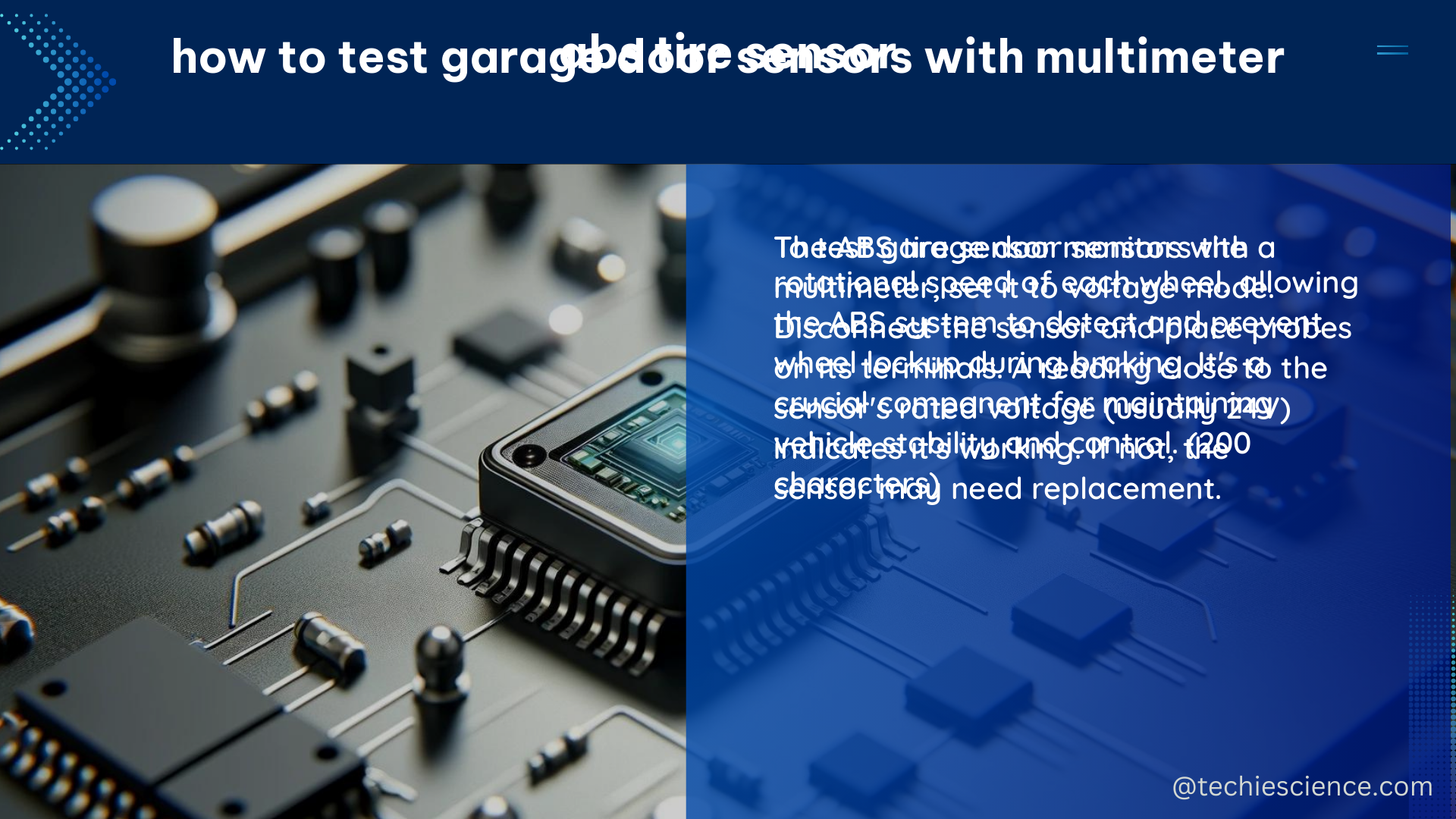The ABS tire sensor, also known as the wheel speed sensor, is a critical component in modern vehicles, playing a pivotal role in the Anti-lock Braking System (ABS) and other advanced safety features. This sensor measures the rotational speed of each wheel and transmits this data to the ABS control unit, which then uses the information to detect wheel slip and adjust the braking force accordingly, ensuring vehicle stability and steerability during critical braking situations.
Understanding the ABS Tire Sensor: Principles and Types
The ABS tire sensor is typically located near the wheel and utilizes either a toothed wheel or a magnetic encoder to generate a signal that changes in frequency relative to the wheel speed. This signal can be either analog or digital, depending on the design of the sensor. The frequency and amplitudes of this alternating voltage are directly related to the wheel speed, with higher frequencies indicating faster wheel rotation.
There are two main types of ABS tire sensors: active and passive. Active sensors require a separate power supply from the control unit, while passive sensors do not. Inductive-passive sensors, a subtype of passive sensors, use a pole pin surrounded by a winding and a permanent magnet to generate a signal when the impulse wheel rotates. Active sensors, on the other hand, are proximity sensors with integrated electronics that are supplied with a defined voltage from the ABS control unit. They use a multipole ring as an impulse wheel, which is integrated into a sealing ring of a wheel bearing.
| Sensor Type | Power Supply | Impulse Wheel |
|---|---|---|
| Active | Separate from control unit | Multipole ring |
| Passive (Inductive-Passive) | No separate power supply | Pole pin, winding, permanent magnet |
Measuring the ABS Tire Sensor Signal

When it comes to measuring the signal from the ABS tire sensor, there are several approaches that can be employed. One way is to use an interrupt and an internal counter on a microcontroller, such as the Arduino Uno, to count the number of pulses per second. This method allows for the calculation of the distance traveled per second and, consequently, the speed in m/s. However, it requires a good understanding of interrupts and timers.
Another approach is to use a frequency-to-tension converter, which converts the frequency of the sensor signal into an analog voltage that can be read directly by the microcontroller. This method eliminates the need to deal with interrupts but requires additional hardware. The frequency-to-tension converter typically has a linear relationship between the input frequency and the output voltage, allowing for a straightforward conversion of the sensor signal into a usable speed measurement.
| Measurement Method | Advantages | Disadvantages |
|---|---|---|
| Interrupt and Counter | Allows for direct speed calculation | Requires understanding of interrupts and timers |
| Frequency-to-Tension Converter | Eliminates need for interrupts | Requires additional hardware |
Factors Affecting ABS Tire Sensor Performance
The performance of the ABS tire sensor can be influenced by several factors, including:
-
Sensor Positioning: The sensor must be positioned correctly relative to the impulse wheel or multipole ring to ensure accurate signal generation. Improper positioning can lead to inconsistent or erratic sensor readings.
-
Sensor Wear and Damage: Over time, the sensor and its associated components can experience wear and damage, which can affect the sensor’s ability to accurately measure wheel speed. Regular inspection and replacement of the sensor are essential for maintaining proper system function.
-
Electromagnetic Interference (EMI): The sensor signal can be susceptible to electromagnetic interference from other vehicle components, such as the alternator or ignition system. Proper shielding and grounding of the sensor and its wiring are crucial to mitigate the effects of EMI.
-
Environmental Conditions: Extreme temperatures, moisture, and other environmental factors can impact the sensor’s performance and reliability. Ensuring the sensor is designed and installed to withstand the operating conditions is crucial for maintaining consistent and accurate measurements.
-
Wheel Bearing Condition: The condition of the wheel bearing can also affect the sensor’s performance, as any play or wear in the bearing can cause variations in the sensor signal and lead to inaccurate speed measurements.
Troubleshooting and Maintenance
Proper troubleshooting and maintenance of the ABS tire sensor are essential for ensuring the continued reliability and performance of the vehicle’s safety systems. This includes regular visual inspections, resistance and voltage checks, and monitoring for any diagnostic trouble codes related to the sensor.
When replacing an ABS tire sensor, it is crucial to use the correct replacement part and follow the manufacturer’s installation instructions carefully. Improper installation can lead to sensor misalignment, which can result in inaccurate speed measurements and potential safety issues.
Conclusion
The ABS tire sensor is a critical component in modern vehicle safety systems, providing essential information about the rotational speed of each wheel. Understanding the principles of operation, types of sensors, and methods for measuring the sensor signal is crucial for maintaining the performance and reliability of these systems. By following best practices for installation, troubleshooting, and maintenance, vehicle owners and technicians can ensure the continued safe and stable operation of their vehicles.
References:
- HELLA GmbH & Co. KGaA. (n.d.). Check and change ABS and wheel speed sensors | HELLA. Retrieved from https://www.hella.com/techworld/us/Technical/Sensors-and-actuators/Check-change-ABS-sensor-4074/
- HELLA PAGID GmbH. (2016). BRAKE DISCS AND WHEEL SPEED SENSORS IN ABS SYSTEMS. Retrieved from https://www.hella-pagid.com/hellapagid/assets/media/Brake_Disc_ABS_PAGID_EN.pdf
- Arduino Forum. (2012, October 8). ABS wheel speed sensor – measuring vehicle speed. Retrieved from https://forum.arduino.cc/t/abs-wheel-speed-sensor-measuring-vehicle-speed/123583

The lambdageeks.com Core SME Team is a group of experienced subject matter experts from diverse scientific and technical fields including Physics, Chemistry, Technology,Electronics & Electrical Engineering, Automotive, Mechanical Engineering. Our team collaborates to create high-quality, well-researched articles on a wide range of science and technology topics for the lambdageeks.com website.
All Our Senior SME are having more than 7 Years of experience in the respective fields . They are either Working Industry Professionals or assocaited With different Universities. Refer Our Authors Page to get to know About our Core SMEs.